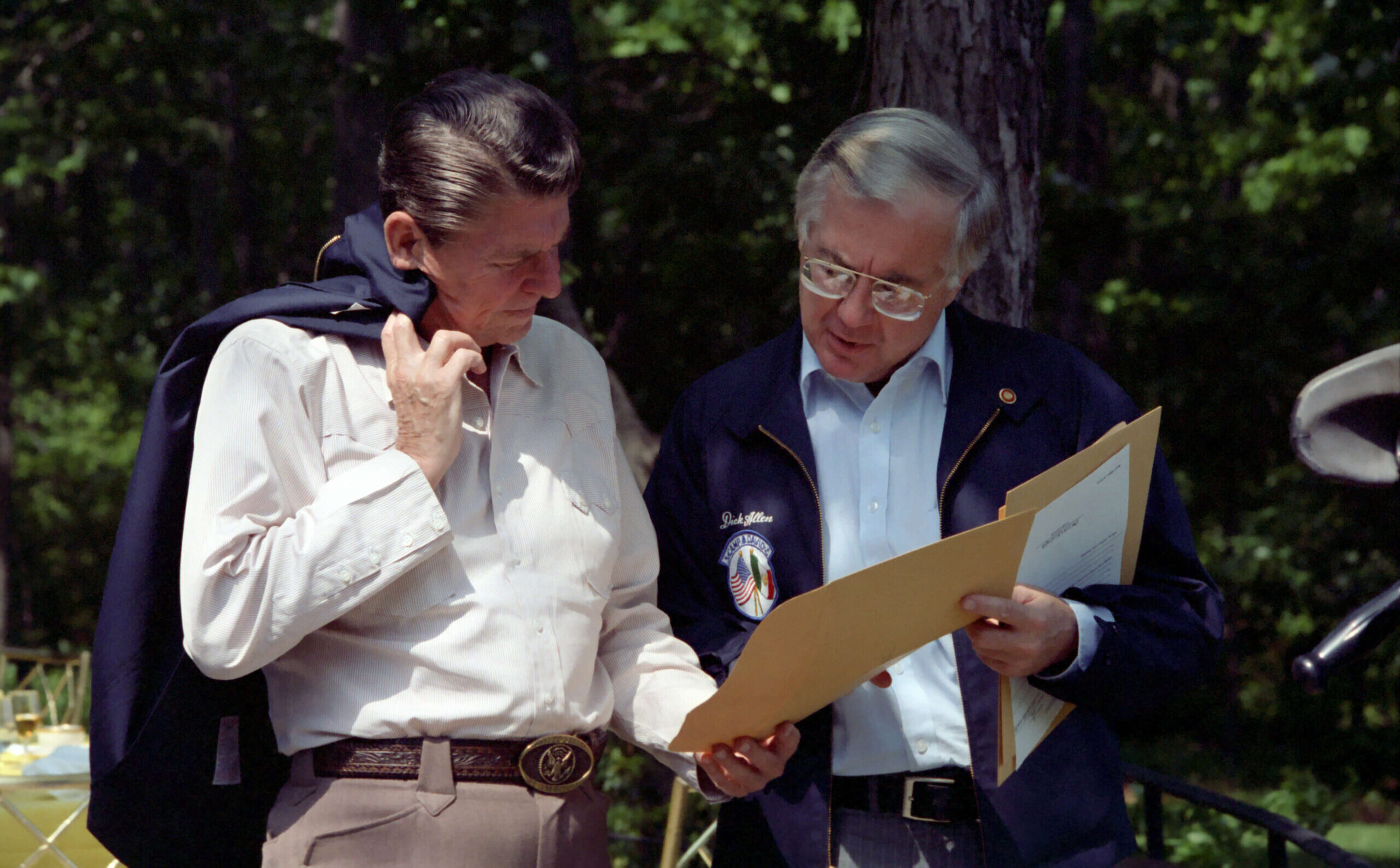Political Political Theory: Essays on Institutions
By Jeremy Waldron
(Harvard University, 2016)
Largely owing to its gloomier aspects, the 2016 presidential election had the virtue, ironically, of shining a bright light on the significance of political processes, procedures, and institutions. To the astonishment of the nation, the Republican nominating process permitted the ascent of celebrity businessman Donald Trump. When Trump prevailed in the general election, the question quickly became whether structures designed to constrain power could in fact restrain such a willful and unconventional figure. The early months of Trump’s administration suggest he will indeed test the regime’s fundamentals—perhaps to an existential degree.
As citizens, we know that institutions matter. Do professors understand that, too? The political and legal philosopher Jeremy Waldron has doubts. In his recent collection of essays, Political Political Theory, Waldron argues that academic political theory has lost sight of the rules and systems that regulate the practice of politics. While the Great Books canon teems with institutionally oriented thinkers (Aristotle, Hobbes, Locke, Montesquieu, the American framers, and Mill, to name a few), contemporary political theorists pay institutions little regard. There are exceptions, such as Harvard’s Nancy Rosenblum, whose work on parties Waldron praises, and the “Straussian” community, which he does not mention. Nevertheless, the general state of affairs is grim.
In Waldron’s view, this neglect of institutions is the intellectual legacy of John Rawls, whose A Theory of Justice (1971) spawned an entire “industry” of scholarship devoted to examining the “ends and ideals” of a “good society.” Theorists inspired by Rawls tend to be preoccupied with abstract debates about justice, morality, toleration, and the common good, rather than with institutional questions.
There is nothing wrong with examining the ends and ideals of political life, but we also have to think about how they might play out in the real world. Waldron seems sensitive to the Platonic—perhaps Socratic—wisdom that theory untethered to any concrete experience can become either dangerously abstract or ridiculous. His motive, however, isn’t mainly theoretical. He wants to improve political practice.
For example, the citizens of a liberal democracy will inevitably disagree about “what rights there are and what they amount to.” Are these disagreements best resolved by an unelected judiciary, by a representative legislature, or in some other fashion? Academic political theorists can help, but their theorizing must be combined with a sophisticated understanding of how courts and legislatures work. Otherwise, their efforts to influence political practice are likely to be misguided.
If theorists neglect the study of institutions and processes, they cede intellectual responsibility for real politics to empirical political scientists. Unfortunately, these scholars often hold “pragmatic or consequentialist values” that render them ill equipped to grapple with “non-consequential[ist]” values such as justice, liberty, and dignity. After all, we don’t just want courts, legislatures, and other institutions to be efficient in their decision making. We want them to have the greatest possible chance to secure the substantive goals of a free society.
Waldron defends the importance of his enterprise in the first and final two essays, but the book mostly illustrates how political theory can be “political”—that is, oriented toward mechanisms, structures, and processes. With his usual piquancy, Waldron explores “big” questions related to constitutionalism, the rule of law, separation of powers, bicameralism, the loyal opposition, judicial review, and representation. These wide-ranging, sophisticated discussions showcase his fluency in jurisprudence, analytic philosophy, political science, and the history of political thought.
In one of the finest essays, Waldron poses what seems a basic question: Why do we subscribe to the doctrine of the separation of powers? We know from the doctrine’s great spokesmen—Montesquieu and Madison—that tyranny will ensue if the powers of government are or become concentrated. However, it turns out that Montesquieu and Madison offer few specifics about why the powers must be divided into the now-familiar three functions: legislative, executive, and judicial. Why this particular “taxonomy”? Couldn’t a different dispersal of power do the job?
Waldron acknowledges that these thinkers might have grasped more than they gave us in the way of explicit argumentation, but he nonetheless seeks clarity. The real reason we need an understanding of governmental functions akin to the familiar tripartite division is because it alone makes possible the rule of law. Two key concepts in the history of political thought—separation of powers and the rule of law—are intimately related.
The division of powers secures the rule of law because it establishes a specific sequence in which governmental functions ought to be exercised. Before the state punishes an individual for breaking a law, that law and any penalties for its violation must have been conceived and made known to citizens in advance. Only after it is promulgated can the law be enforced. Public awareness doesn’t eliminate disputes about meaning or application, however. The disputes must be adjudicated in court, with due process ensured for the alleged lawbreaker.
More than a distinction among governmental functions, then, the separation of powers is a kind of schedule for ensuring the rule of law. In the absence of such a schedule, power could be exercised in an arbitrary way.
Waldron’s interest in these themes is not antiquarian. Appreciating the arguments for the separation of powers, for example, is vital to any honest assessment of contemporary political phenomena, including judicial lawmaking and administrative rulemaking.
These arguments also equip us to reflect candidly on the virtues and vices of “Westminster-style” constitutions, which unite legislative and executive power. In systems modeled on Britain’s, members of the executive branch—the prime minister and cabinet—are chosen from Parliament and retain their seats. In principle, this seems to allow legislative control of the executive, particularly in a case like Britain’s in which the weakness of the House of Lords makes the legislature only nominally bicameral. In principle, the House of Commons is ascendant. Waldron worries that in practice the Commons’s “ascendency” facilitates “executive domination” of the legislative agenda, as the majority party in the Commons is highly motivated to support the government it has chosen. Such a system is well configured for getting things done. However, there is probably less genuine legislative deliberation than in a system of separated powers.
As he examines separation of powers, bicameralism, and other aspects of modern constitutionalism, Waldron advances a larger argument about the purpose of these structures and mechanisms in relation to democracy. The traditional theory opposes constitutionalism and democracy. On this view, institutions protect liberty by constraining potentially tyrannical majorities. Waldron contests this view of constitutions and constitutional devices, which he conceives of as vehicles of democratic empowerment. Ordinary citizens are weak on their own, but constitutions “empower” them to take “affirmative” control of their political institutions. Constitutional features such as representation and bicameralism are not merely “brakes on the lawmaking process.” Rather, they make genuine self-government possible by “structuring deliberation, allowing a multiplicity of voices to be heard, and securing multiple points of access for citizen input.”
Although he plays up the idea of democratic empowerment, there is less distance between Waldron and the traditional view of constitutions than his language suggests. Like most of the canonical thinkers, Waldron is perfectly willing to use institutions to constrain democracy. His position on the role of constitutional structures and processes might thus be more accurately described as advocating limited democratic empowerment. A well-designed constitution allows the people to rule, but not to do anything it wants.
Consider Waldron’s opposition to so-called strong judicial review. Although he argues that rights disagreements should be settled by legislatures whenever possible, he also assumes that these legislatures are constituted in a manner that discourages majority tyranny. He insists on a diverse representation and “procedures for lawmaking” that are “elaborate and responsible” and that “incorporate various safeguards, such as bicameralism, robust committee scrutiny, and multiple levels of consideration, debate, and voting.” These complex institutional arrangements represent an effort to limit the power of temporary majorities. Waldron can criticize judicial intervention to protect individuals because he assumes that other institutions already do so.
Moreover, Waldron’s distinction between institutions’ “affirmative” role of empowering citizens and their “negative” role of limiting democracy is semantic. Take representation. Adequate schemes of representation facilitate republican rule. By “channeling” the people’s political energies and structuring their political participation, the forms and structures of representative government make it possible for them to voice their concerns and defend their diverse interests effectively. These same structures filter and refine the public’s judgment, which Waldron distinguishes from and elevates above its will. Without such filtering structures, one risks what Hannah Arendt called the “chaos of unrepresented and unpurified opinions.”
Waldron is determined to avoid the language of “restraint and limitation.” But doesn’t the “channeling” and filtering of public opinion amount to the same thing? In practice, any scheme of representation involves both empowerment and limitation. There is less distance between Waldron and Madison than meets the eye.
But Waldron may have his own “political” reasons for avoiding too strong of an identification with Madison. Identifying with Madison could mark him as too much of a traditionalist or a conservative, potentially alienating his academic audience. However, as an advocate of democratic empowerment with a series of prestigious appointments at Berkeley, Columbia, Oxford, and New York University, Waldron is well positioned to serve as a gadfly for the political theory establishment. In advising a return to some “old-fashioned” topics, Political Political Theory indicates a way forward for those who seek to study politics in a manner that might actually illuminate it. ♦
Sara Henary is assistant professor of political science at Missouri State University.














